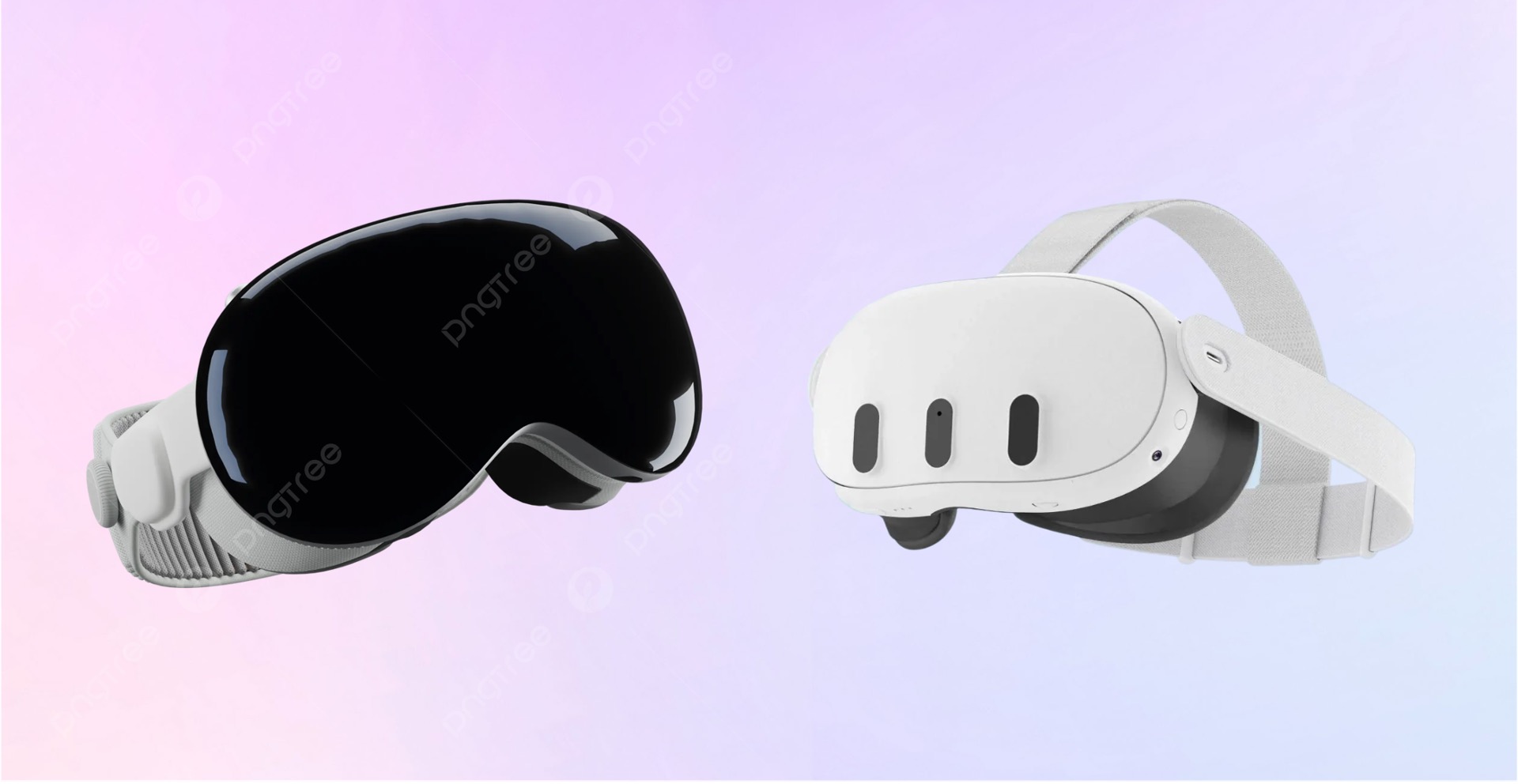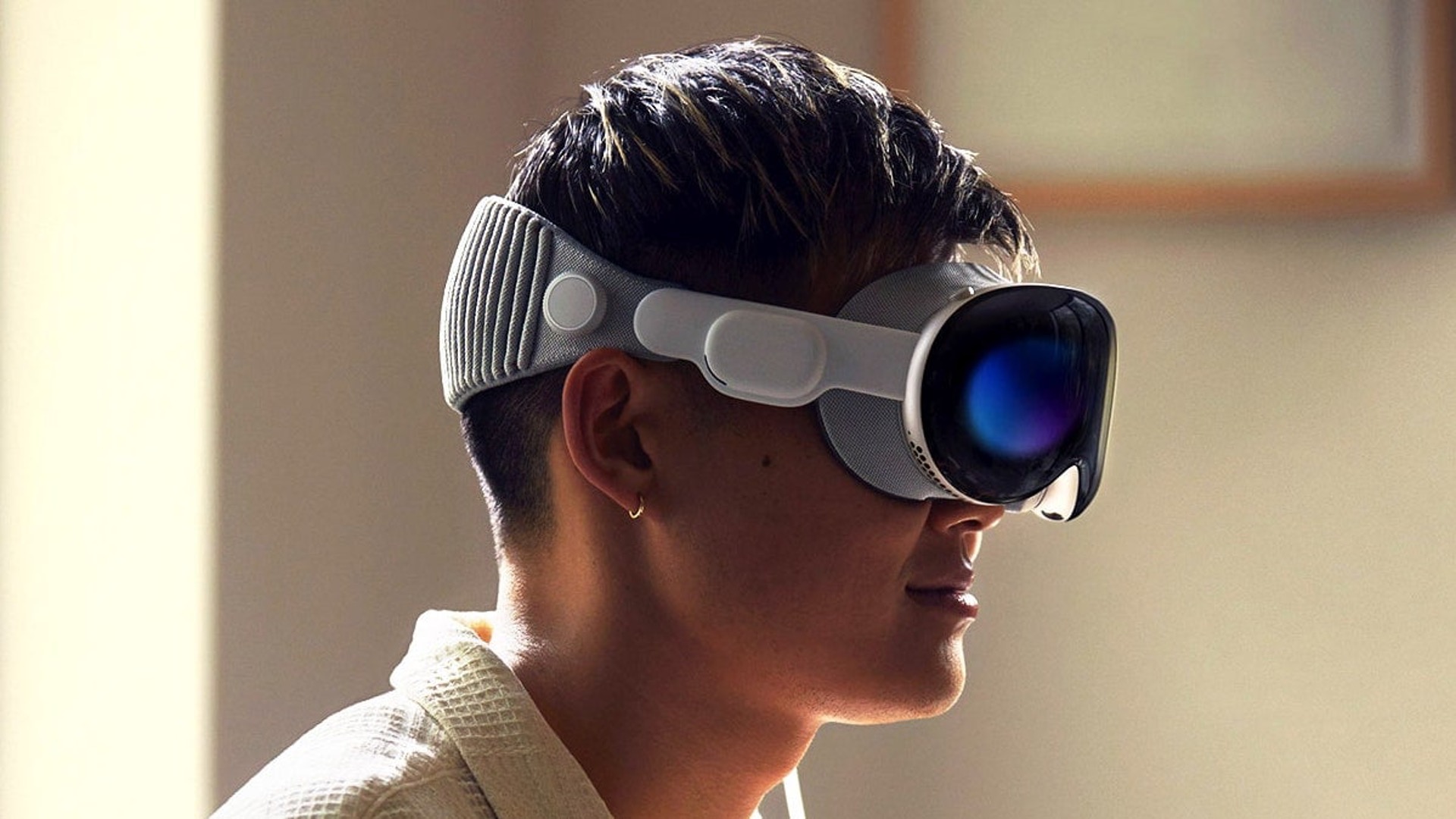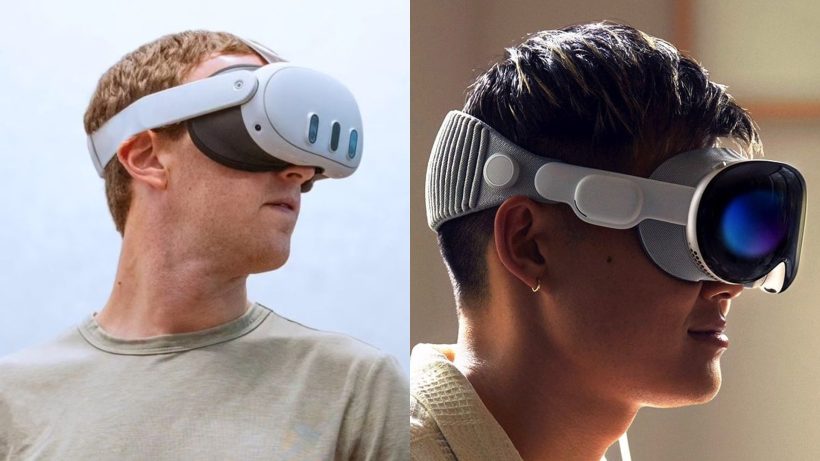The Apple Vision Pro which was released on 2 February 2024 is Apple’s answer to the Meta Quest 3 headset. Comparatively speaking, the Apple Vision Pro comes with a lot of impressive technology built into the headset which makes it a technological marvel, and is designed for entertainment and productivity. The Vision Pro also supports spatial video with 360 degree video recording which sets it apart from the Meta Quest 3 headset. Meta has rushed out an update to the Quest 3 headset to support spatial video in conjunction with the Apple Vision Pro’s release.
The Meta Quest 3 VR headset, in contrast, is much less expensive than the Apple Vision Pro and a more affordable option for the everyday gamer. While it doesn’t come with the same OLED display that the Vision Pro has, it delivers a good mix of productivity and gaming and supports modern features such as camera passthrough. With that said, we found the Meta Quest 3 to be a better gaming headset overall and more geared towards gaming as compared to the Vision Pro’s controls (which can be a little challenging to control).
Apple has announced that more than 600 apps and games will be supported on the Apple Vision Pro with spatial experiences that can transform any room into a theater for gaming, TV shows and films.
The Apple Vision Pro is available directly from Apple or through walk-ins in any Apple store.

Comparing the Specs
| Specification | Apple Vision Pro | Meta Quest 3 |
| SoC (System on Chip) | Apple M2 chip, R1 Apple Silicon chip | Qualcomm Snapdragon XR2 Gen 2 |
| Display Resolution (Per-eye) | 2160 x 3840 | 2064 × 2208 |
| Display Type | Micro OLED | LCD |
| Refresh Rate | 90Hz | 120Hz |
| Field of View | Smaller than the Quest 3’s 110 degrees | 110-degrees horizontal/92-degrees vertical |
| Lenses | Pancake | Pancake |
| Features | Ambient Spatial Audio, EyeSight, Mixed reality, Hand tracking, Gesture control | Hand tracking, PC compatibility, Voice commands, Wireless, Mixed reality |
| Controllers | Not applicable (relies on hand gestures) | Touch Plus controllers |
| Weight | 600g | 513g |
| RAM | 16GB | 8GB |
| Storage | Up to 1TB | Up to 512GB |
| Audio | Two Speakers with Spatial Audio | NFC Speakers |
The Apple Vision Pro stands out for its ultra-high resolution displays that provide more pixels than a 4K TV for each eye, so that users can watch TV shoes or movies akin to a 1100 foot screen. Unlike many VR headsets which are predominantly made of plastic and can appear somewhat ungainly, the Vision Pro boasts a construction of magnesium and carbon fiber enclosed in aluminum. This design choice echoes the familiar aesthetic of Apple’s product range, incorporating elements reminiscent of the iPhone 6, AirPods Max, and Apple Watch. With the NBA app on the Apple Vision Pro, basketball fans can now stream five broadcasts live with Multiview and keep an eye on real-time player and team stats in real time. You can also watch Red Bull TV with 3D maps of races paired with immersive environments, transforming the way you watch TV. Many people have noted that the Vision Pro looks surprisingly compact, especially when compared to the bulkier VR headsets that have been common over the last ten years.
A notable feature of the Vision Pro is its front display, which is designed to reduce the sense of isolation often experienced when using VR headsets. This feature allows users to stay visually connected with their surroundings and the people around them while immersed in a virtual experience.
Compared with the Meta Quest 3, the Apple Vision Pro includes new specs such as local dimming, eye tracking, and face tracking. It is equipped with a micro OLED display, delivering an exceptional visual experience with a high resolution of 2160 x 3840 per eye. This resolution, combined with advanced display technologies, provides an incredibly immersive and vivid visual experience. The Vision Pro is powered by Apple’s M2 chip and R1 Apple Silicon chip, emphasizing its performance capabilities. The design of the Vision Pro resembles a pair of premium ski goggles, and it supports interaction through hand and finger gestures along with compatibility with Apple’s magic keyboard and trackpad. This gives you plenty of options to play around and even set timers over objects while cooking in the kitchen, which is an entirely new way to experience better productivity with augmented reality.
The Meta Quest 3, by contrast, is a more affordable option that is designed for everyday gamers. It offers a robust VR gaming experience with a more powerful GPU compared to the Vision Pro. The Quest 3 features a Qualcomm Snapdragon XR2 Gen 2 SoC and a high refresh rate of 120Hz, enhancing the gaming experience. The display is an LCD panel, offering a resolution of 2064 × 2208 per eye. The headset’s design is an iterative update over its predecessor, being slimmer and more refined. It includes hand tracking, PC compatibility, and supports full-color passthrough for mixed reality experiences. The Quest 3 is aimed more at VR enthusiasts and gamers, making it a more versatile option for those interested in a wide range of VR experiences and is definitely more economical than the Apple Vision Pro.
In essence, the Apple Vision Pro is positioned as a luxury, high-end device offering advanced technology and features, ideal for users seeking the pinnacle of VR experiences and willing to invest in premium technology. The Meta Quest 3, on the other hand, is a more cost-effective option which focuses on delivering a quality VR gaming experience and broader VR applications.
We would go further to say that the design of the Meta Quest 3 is notably functional, characterized by a simple white plastic exterior. The front of the headset features three oblong modules that accommodate various cameras and sensors. The headset is supported by a Y-shaped strap that extends over and behind the user’s head, offering a secure fit.
Meta has introduced additional strap options in Blood Orange and Elemental Blue, as well as different facial interfaces, catering to users who prefer a personalized touch to their headset.
A significant enhancement from previous models, the Meta Quest 3’s design focuses on improved weight distribution. By positioning the center of gravity nearer to the face, the headset offers a more stable fit.

Use Cases Compared
The Apple Vision Pro emphasizes augmented reality (AR) as well as virtual reality (VR) capabilities, effectively making it a mixed reality headset. It’s designed to allow users to interact with people in their physical presence, addressing the common issue of isolation associated with VR and AR headsets. The Vision Pro’s 3D mapping systems and displays contribute to a more realistic standard view of the outside world, enhancing user safety and the ability to acknowledge others in the vicinity. The Vision Pro’s design and display quality are outstanding, with high-resolution micro-OLED displays and an intuitive, controller-free interaction system utilizing eyes, hands, and voice. It seems more aligned with productivity and content consumption rather than for fast-paced VR games that the Meta Quest 3 is more geared towards.
On the other hand, the Meta Quest 3 is powered by a Snapdragon chipset and operates on an Android-based system. It is known for its vast app and games library, offering popular VR games like Beat Saber, Gorn, Resident Evil 4 VR, and more. The Quest 3 is equipped with an LCD display, providing a 120Hz refresh rate and a resolution of 2064 × 2208 pixels per eye. It is designed more for VR gaming and entertainment, with immersive haptic feedback controllers and a more portable experience due to an integrated battery. The Meta Quest 3 also offers hand-tracking functionality for a controller-free experience but includes the option of using Touch Plus controllers for a more tactile interaction.

Display and Design
The Apple Vision Pro features a micro OLED display which provides a stunning 4K resolution for each eye. This high-resolution display, coupled with a brightness of 5000 nits, offers exceptionally bright and clear visuals. This is arguably better than the Meta Quest 3 device which uses a single LCD panel, with a resolution of 2064 × 2208 per eye and a 120Hz refresh rate. Although it offers a good resolution, its peak brightness is significantly lower at around 100 nits, making it dimmer compared to the Vision Pro.
One of the things that we liked about the Apple Vision Pro is that it resembles high-end ski goggles, which allows you to use augmented reality in conjunction with real life experiences. It has a unique 3D display at the front that can display the user’s eyes, creating an immersive VR experience. It operates without external controllers, relying on hand and finger gestures for navigation. However, it has a smartphone-sized external battery tethered to the headset with a wire which we found to be rather cumbersome at times.
The Meta Quest 3 features a more traditional head-mountable design with an array of sensors, including external cameras and a depth sensor at the front. It is more compact than its predecessor and offers full-color passthrough for mixed reality experiences. The device includes Bluetooth-enabled controllers but also supports finger and hand gestures. Its integrated battery offers a truly wireless experience.
The Verdict?
Overall, we preferred the Meta Quest 3 headset over the Apple Vision Pro. While the Apple Vision Pro headset does come with numerous impressive features and a 4K OLED display, it seems more like a prototype VR headset rather than something designed for practical use. The Meta Quest 3, by contrast, has gone through several iterations and improvements over the years, and is the kind of everyday headset that you would actually have practical applications for such as gaming. The Apple Vision Pro with its ski-goggle design, seems more geared towards productivity such as watching TV, movies and tasks, and it is not entirely clear how you can game with the Vision Pro by using gesture controls (how would you expect to game with gesture controls?). Apple may have to make some improvements to the controls in this regard or introducing something like the Meta Quest Touch Plus controller which pairs seamlessly with the Meta Quest 3 headset.
One advantage that the Apple Vision Pro has over the Meta Quest 3 is that it supports spatial video which can be filmed on the new iPhone 15. That being said, Meta has indicated that they will roll out support for spatial video for its Meta Quest headsets to bring it in line with Apple’s Vision Pro. While the Vision Pro is no doubt a good headset, we found that the current level of functionality that you get with this headset does not justify the cost of getting it at the moment.

